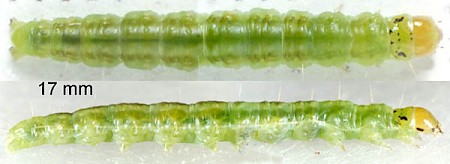
49.025 BF970
Barred Fruit-tree Tortrix Pandemis cerasana
(Hübner, 1786)
Wingspan 16-25 mm.
This is one of several quite similar 'tortrix' moths, which hold their wings in a flattened, bell-shape posture when at rest.
It is quite a common species throughout much of Britain, flies from June to August, from dusk into the night, and is attracted to light.
It is to be found in gardens, orchards and other woodland areas, the foodplants being many kinds of deciduous trees, especially fruit-trees.
- Larva: (description Ian F. Smith):
Foodplants: September to May in rolled or folded leaf on many deciduous trees, including fruit trees, Acer, Alnus, Betula, Corylus, Quercus, Salix, Sorbus, Tilia and Ulmus. Also on Vaccinium and Lysimachia.
Late instar:
Length: 16 mm described.
Head: Pale green frons. Capsule; yellowish brown with light green tints. Mouthparts dark brown. Black postero-lateral mark. Stemmatal area black.
Prothorax: Translucent apple green. Prothoracic shield; pairs of black spots and, laterally, black crescent.
Thoracic legs: Translucent pale green with yellowish tarsus.
Body: Translucent apple. Contractile dorsal vessel shows as darker dorsal line. Integument may be coloured to suggest indistinct lighter subdorsal band and darker lateral band .
Spiracles: Whitish green with fine pale brown peritreme. Largest on A8 & T1.
Pinacula: Concolorous, unobtrusive.
Setae: Translucent colourless.
Anal plate: Light green.
Prolegs: Concolorous. Crochets light brown.Similar species: 969 Pandemis corylana is very similar in late instar. The black markings on the prothoracic plate are almost identical, but perhaps coarser on cerasana. The body is usually apple green in cerasana and jade or emerald green in corylana. Time of year should help separate them; cerasana is a larva over winter from September to May, corylana from May to July. In May cerasana is full grown while corylana is in early instar. Until more illustrations and descriptions are available of other related Tortricid larvae, identification should be confirmed by raising the larvae.

 UKMoths
UKMoths 








